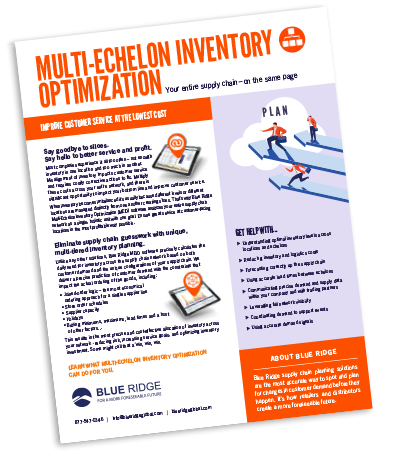Does Multi-Echelon Management Matter?
The Evolving Supply Chain Industry
As you reflect back on the language of retail and distribution, it is interesting to see how the description has changed over the years. While the actual functional areas change, there are also new buzzwords that come about.
While the actual functional areas change, there are also new buzzwords that come about.
I think back to when I started my retail career. I worked in the inventory management area. My role wasn’t entirely different from what we now call supply chain, or supply chain planning. Online shopping became e-commerce, which then became omni-channel, digital retail, etc. Shared solutions became hosted solutions, which then became ASP, SaaS, Cloud, etc.
The functions grew to be more sophisticated and broader, and everyone wanted to be speaking in the latest catch phrase. Some people who used the new terminology didn’t actually do anything differently. In reality, they wanted to be buzzword compliant, lest they appear to be something other than a modern solution.
The notion of multi-echelon is potentially the same. Many companies will talk about having a multi-echelon solution. I can envision virtual head-nodding as I imagine a software salesman being asked if their solution supports multi-echelon. It’s important to first understand the business issue we are trying to solve. Once we understand that, we can truly evaluate the solution needed to solve the issue.
What Does Multi-Echelon Really Mean?
Multi-echelon is one of those business issues everyone needs to understand. When the industry first started talking about vendor collaboration, improving supply chain efficiency and such, we talked about providing a forecast to our suppliers. This was done by putting the sales or shipment forecast into a spreadsheet and forwarding it to our suppliers. These days, that is a woefully inadequate means to make any substantial improvements to the supply chain. Here’s why:
- If you plan to sell 10, 10, 10, 10 each week, how does that indicate your need for supply? It doesn’t…at all
- Suppliers need to know that you will be ordering 40, 0, 0, 0. There’s a significant difference here
How to Plan for This Demand
The latter is a more precise piece of information that allows suppliers to have the proper amount of goods ready to ship when you order. The same concept is true within your own supply chain when supplying stores from a DC.
Translating demand from the lowest level or echelon possible, the customer, helps to predict demand properly. Consider how your customer buys. Their pattern and rate of demand helps you know how many selling units you must have in the store on each day.
Consider This Scenario
If a store is replenished daily, it is not so important to know how many units go out through POS, but rather how many need to come in the back door. Suppose for example:
- Customers buy 2 pieces of a widget each day. That would be 12 pieces per week (we are closed on Sunday).
 If the store they buy from orders once each week, they will order the next week’s supply of 12.
If the store they buy from orders once each week, they will order the next week’s supply of 12.- Now you must recognize that the item in question is shipped to the store in a case of 24. This means the store orders one case every other week.
- Still, there are additional supply chain rules to consider. These 24 case-packed items are shipped with 4 cases to a layer and 6 layers to a pallet.
- So the store can order either in layers of 96, or pallets of 576.
- This means that the order to the distribution center will be placed either once every 8 weeks, or about once per year for the pallet.
For simplicity, this example, is only for one store, and one upper echelon, and one item from this supplier. In reality, as you add more stores ordering on different days with differing volumes, thousands of items from multiple DC’s that may be serviced from a hub and spoke supply chain, it becomes impossible to manually determine when goods need to be ordered.
Navigating the Complexities
The significant complexity of the process makes it unproductive at best to provide the supplier with only a demand forecast or even a roll up of the store ordering levels. To solve this dilemma, you need to think about multi-echelon as being driven by how lower echelon (store/site) demand is translated into order demand from the upper echelon (DC, supplier).
- Customers buy in singles on a daily basis
- The store orders case packs, say weekly or a few times a week
- Another rounding multiple is used by the supplying DC or supplier
All of the demand translation activity has to be combined for the multitude of items in a supplier’s assortment. When confronted with multiple stores, multiple rates of sale and differing ordering frequencies and timings, building effective and efficient orders becomes very complex. The ability to develop the next higher echelon forecast, driven by the appropriate demand signal is what an advanced multi-echelon solution provides.
Looking at the process from the top down, the requirement is to determine how much and when to order from the supplier so that you can fulfill the upcoming requirements of the stores, considering supply chain rules, in order to have the correct amount of inventory at the store for the customer when they walk in to buy.
There are Multiple Types of Demand Signals and Forecasts
- Independent demand only occurs when the end customer purchases.
- Higher-level echelons require a dependent demand signal. The forecast for higher echelons is dependent on something else such as store order schedule, pack rounding, order minimums, etc.
When factors such as lead time, lead time variability, safety stock, shelf stock, shelf life, etc., get added to the mix, it’s clear that the demand translation required to forecast the ordering process and communicating that to the supplier, cannot be done manually.
The Importance of Multi-Echelon Inventory Optimization
As supply chains have become more complex, and the need for greater customer service performance gets more competitive, multi-echelon matters. If you have stores and DC’s, or a hub-and-spoke DC environment, multi-echelon should matter to you, too. The notion of properly joined, time-phased ordering is at the heart of a mature multi-echelon inventory optimization tool.
The difference between the old ways of providing a sales summary or order forecast, versus providing well integrated order forecasts built to buying multiple, truckload, or other constraints at each successively higher echelon, is so much more than a new name for the same thing. It’s a foundational advancement required to be effective.
Challenge yourself to determine if you are using the right forecast to allow you to order with the proper timing and quantity to meet your end customers’ demand. The difference matters. And in today’s competitive marketplace, it may be a deciding factor in whether or not your company survives and thrives.
![]()
Blue Ridge
View From the Ridge



Comments are closed.